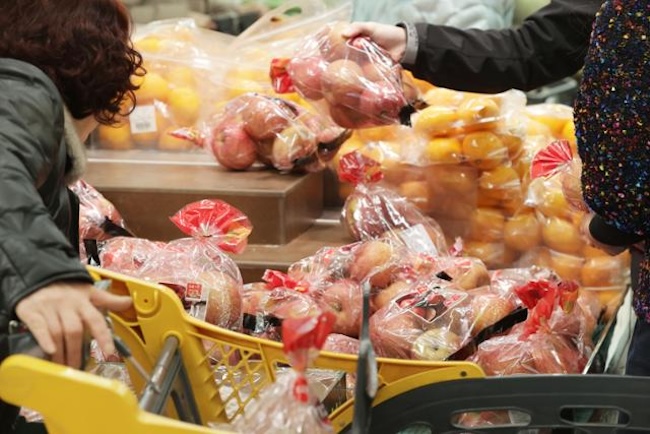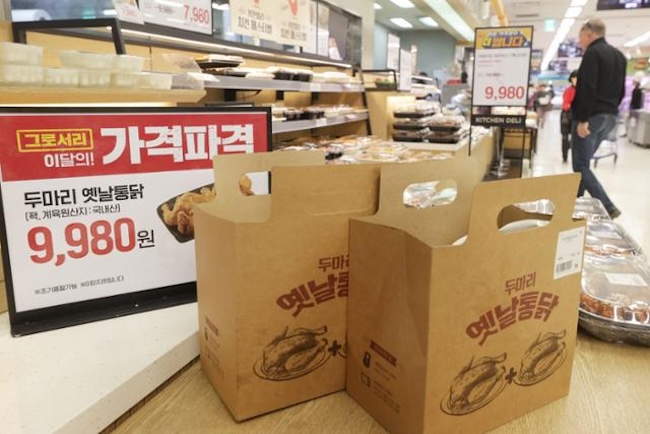
Elusive price increases led by fruits and vegetables such as apples, pears, and green onions continue to burden consumers. (Image courtesy of Yonhap)
SEOUL, Mar. 12 (Korea Bizwire) – Two years into the era of high inflation, elusive price increases led by fruits and vegetables such as apples, pears, and green onions continue to burden consumers.
Following the hike in gasoline and the cost of eating out in previous years, the soaring prices of everyday food items have become the latest source of worry.
In response, adopting frugal spending habits has shifted from a choice to a necessity, leading to a widespread ‘penny-pinching’ trend among South Koreans.
According to Statistics Korea, the inflation rate, which dropped to the 2% range in January, climbed back to 3.1% in February.
Agricultural products had the most significant impact on this increase, contributing 0.8 percentage points to the inflation rate, marking a shift from gasoline and dining out in previous years as the leading drivers of price increases.
This underscores the growing role of agricultural products in driving inflation.
Consumers, already shocked by the persistent high prices, faced further dismay as prices for agricultural goods failed to decrease after the Lunar New Year holiday, contrary to expectations.
To cope with the high cost of living, consumers are adopting a variety of purchasing strategies including saving, sharing, and swapping.
This involves either reducing overall spending or opting for cheaper alternatives within the same product category, a necessity as wages fail to keep pace with inflation, resulting in only marginal increases in disposable income.

Emart’s promotion, “Two Whole Chickens for 9,980 Won,” which saw 40,000 sets sold in just six days after launch, highlights the strong consumer demand for affordable choices. (Image courtesy of Yonhap)
Emart’s promotion, “Two Whole Chickens for 9,980 Won,” which saw 40,000 sets sold in just six days after launch, highlights the strong consumer demand for affordable choices.
Similarly, Daiso, a low-cost retailer, reports that products priced below 2,000 won account for 60% of its sales.
The trend of belt-tightening has become a common sight. In Seoul’s Yongsan Emart, shoppers were seen browsing discounted items, including the chicken deal.
Some consumers have also started to buy groceries in smaller quantities, from a week’s worth to just a day’s worth, to minimize waste. One parent of twins mentioned preferring neighborhood supermarkets for daily essentials like vegetables, fruits, and meat, to avoid bulk buying.
In light of rising prices, some consumers are switching to cheaper imported goods or low-cost retailers.
A consumer in her 60s shared that she has started buying frozen pork belly from countries like the USA and Spain, despite previously only purchasing domestic fresh pork belly. She noted that while imported pork sometimes has a stronger odor, it’s more affordable and the quality is acceptable.
The phenomenon of consumers tightening their belts has become a part of daily life. Following last year’s trend of ‘no-spend challenges,’ the ‘cash-only challenge’ has gained popularity among people in their 20s and 30s, aiming to avoid unnecessary spending by leaving credit cards at home.
The practice of consuming convenience store lunches to save on dining out has also become common, with CU convenience stores reporting a 26.8% increase in lunchbox sales from the previous year.
Professor Lee Young-ae from Incheon National University’s Department of Consumer Science observes, “There was a time when consumers wouldn’t immediately cut back on spending despite having less money due to inflation, but it seems that period has passed. The notion that it’s truly time to save has now spread widely among consumers.”
Ashley Song (ashley@koreabizwire.com)






